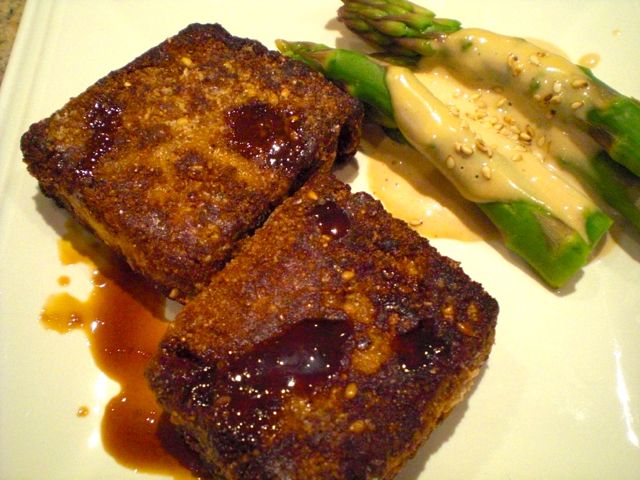The name "Tatsuta-age" 竜田揚げ is usually applied to marinated and fried chicken, which is a teiban 定番 or regular dish in Izakaya. I have mentioned the origin of the name previously when I posted chicken tatsuta-age. In any case, this dish is similar in that the tofu is first marinated, then fried.
Marinade: I made it simply with soy sauce and mirin (1:1). I marinated the tofu overnight in the refrigerator.
Dredging: This is a mixture of sesame seeds and potato starch or katakuri-ko 片栗粉. I first dry roasted white sesame seeds (2 tbs) using a dry frying pan. I then ground them coarsely using a Japanese mortar and pestle (suibachi すり鉢). I mixed the ground sesame seeds with about the same amount of potato starch.
After blotting the excess marinade from the tofu using a paper towel, I dredged the tofu in the above dredging mixture and shallow fried in peanut oil on medium low flame for 2 minutes on both sides or until nice brown crusts formed. Meanwhile, I reduced the marinade until a syrupy consistnecy was obtained.

As a side, I microwaved asparagus tips and dressed them with a sesame mayonnaise (mixture of white sesame paste or nerigoma 白練り胡麻 and mayonaise - about 1:2 ratio, with a small amount of soy sauce. I added water to adjust the consistency) garnished with sesame seeds. Just before eating, I added the reduced marinade on the tofu and severed extra sauce on the side in a small bowl.
The crust really made this dish, It had a nice crunch with a good sesame flavor. Tofu was nicely seasoned but the addition of the reduced marinade was also perfect. The only thing is that this has to be eaten immediately while it is piping hot otherwise the moisture from the tofu wilts the lovely crunch of the crust.






